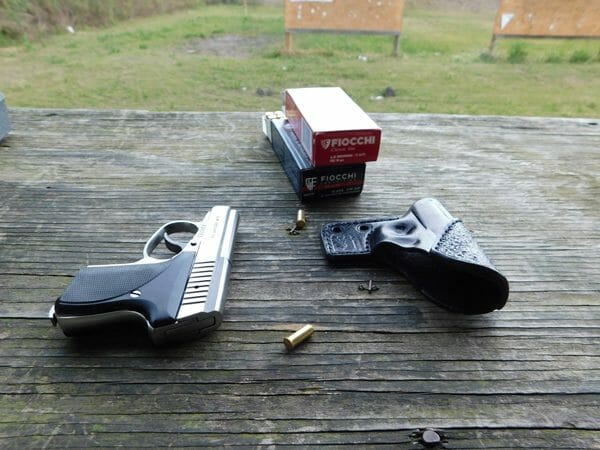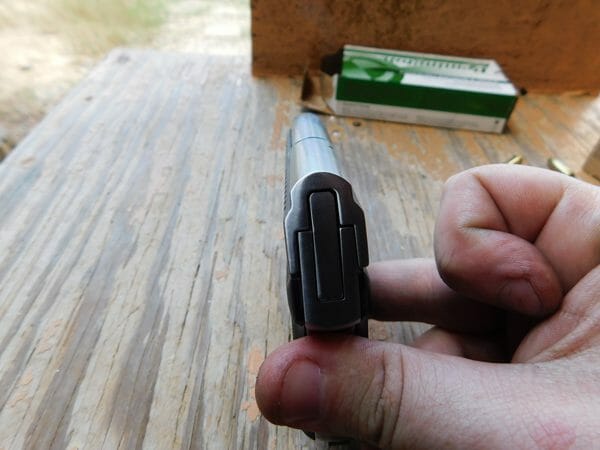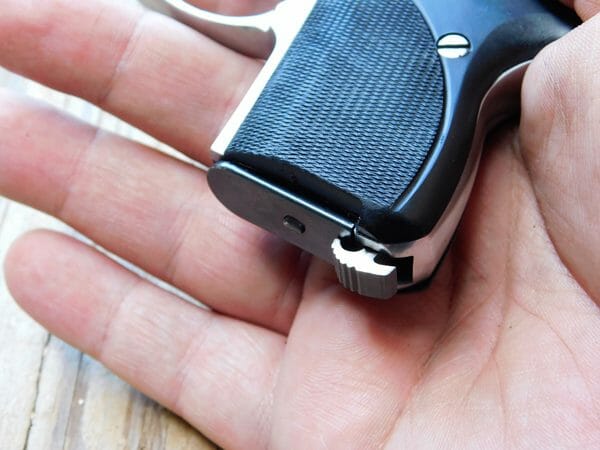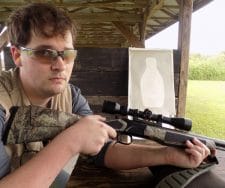Terril James Hebert reviews and shoots the iconic Seecamp LWS 25 Pistol.

USA -(Ammoland.com)- In the early 1970s, the Gun Control Act had left the pocket pistol market in a quandary. Good, imported pistols were banned and the response was a flood of American pistols that had none of the reliability or finesse of those imported guns. Ludwig Seecamp responded to this with his LWS 25 chambered in 25 Auto.
It had the quality levels of those European guns but was made for practical defensive shooting in mind. It was a hit and soon accompanied by variants chambered in 32 ACP and 380 ACP, but demand soon overtook the limited supply runs and there were yearlong waits just to get a Seecamp.
Despite the march of bigger names into the pocket gun market, Seecamp’s pistols are still in high demand. Though the 32 and 380 pistols are still in production and are more prevalent, I opted for the original 25, Seecamp’s original pistol, and one of the last quarter-bores still being produced.
First Impressions and Basic Features

The LWS 25 coming from Seecamp looks like a ho-hum, albeit shiny pocket rocket at first glance. Snag-less, safety-less pocket pistols are the norm now and the Seecamp has a few direct imitators. When I first put my hands on the pistol it felt hefty, despite being only four inches long. This is owing to the LWS’s stainless steel construction.
However, the pistol still weighs in at under thirteen ounces fully loaded with six rounds of 25 ACP in the magazine—lighter than competitive with the aluminum and polymer-framed options out there, but much more durable. The Seecamp lacks obnoxious safety levers and tiny sights found on previous pocket pistols.
There is no manual safety and no iron sights to snag on anything. This pistol was designed as an instinctive point-and-shoot interface. Operationally, the LWS 25 is a blowback-operated pistol, and racking the slide was gritty and a bit tough on account of having a stout spring to fight.
That recoil spring is what keeps the gun shut while it fires. The gun is hammer-fired, but it cannot be cocked as the hammer is recessed into the frame, making the gun double action only. One long pull of the trigger fires the gun. This long trigger pull functions as a safety for carry purposes.
A few features on the Seecamp remind me of the Walther P38, the handgun used by Ludwig Seecamp during World War II. The Seecamp borrows an open-top slide, the double-action trigger principle, and a heel-style magazine release from that classic German pistol.
Seecamp LWS 25 Pistol On The Range
I’ve been a fan of the 25 ACP cartridge for years, despite the round’s very light ballistics. I was excited to have another 25-caliber pistol in the wheelhouse. So for the Seecamp, I assembled my ammunition to include Remington UMC and Fiocchi 50 grain full metal jacket rounds as well as Hornady XTP, Fiocchi Extrema, and Speer Gold Dot 35 grain hollow-points.
On the range, the Seecamp had its own quirks that bore out on its performance. The pistol came with only one magazine, which is a bit of annoyance. I think the Seecamp should come with two magazines. It would go a long way to reloading quickly and it would have saved my thumbs too. Loading the sixth round into the magazine was a little tough, but most pocket pistol magazines are a little tough.
Loading the pistol involves inserting the magazine and letting the heel catch lip over it. Rack the slide and let it go. I aimed at my seven-yard target and let fly. And when I say aimed, I mean lining up the top of the pistol’s slide with the target, holding low, and yanking the trigger as fast as I could. I got four shots on that twelve-inch bullseye in two seconds. The other two were not far off.

After that bit of tomfoolery, I went for accuracy at that distance. I fired as fast as I thought I could hit the small three-inch circles. I was rewarded, at best, with a 2.5-inch group, though 4-6 is more typical.
Not bad for a gun with a fixed two-inch barrel with no sights and a heavy trigger pull for each shot. Further out at twenty-five, I tried again. Only in my optimistic mind, would anyone try shooting a pocket 25 at… 25 yards. I tried it only once and got four out of the six on the twelve-inch bullseye.
In terms of handling and shooting, the Seecamp is mostly great even with the abbreviated features of the gun. With barely two fingers grip on the gun, I found anchoring the pistol deep into my palm with the pad of my finger on the trigger at all time to be most accurate.
I found it made just as much sense to shoot the pistol one-handed than with two. The trigger pull is long but not as heavy as it appears, coming in at under ten pounds. When it is pulled to the rear, the first half of travel is mostly trigger-take-up. Only the last half has any weight to it and it breaks unexpectedly.
Reliability is often a category that pocket pistols suffer. The Seecamp didn’t ail much in that department. I found that Fiocchi 50 grain FMJ ammunition occasionally caused an issue by weakly ejecting from the pistol and getting caught between the slide and barrel. The total number of those malfunctions was two.
Otherwise, the pistol fed everything reliably and fired reliably. I chalk up those malfunctions to the ammunition, being the weakest load I tested.
Recoil was very pleasant and the report was little more than a resounding pop. You won’t find yourself hurting from shooting this pistol. The pistol is easy enough to use with no manual safeties or buttons to remember.
The recoil spring is the only part of the action that holds the gun together while firing and it doesn’t give much resistance to racking the slide, which got easier and easier in the test. The heel magazine release takes some getting used to but is a smart necessity on a pocket handgun. A conventional button could accidentally be depressed causing the magazine to fall out. Not good outside a range setting.
Disassembly requires the use of a punch—purpose-made or otherwise—and an empty case. Pull the slide back and push the empty case mouth up into the action to let the slide suspend away from the barrel. Depress the détente on the left side of the slide and pull the slide back and up. The slide comes off and the recoil spring comes out. You will need the magazine in for initial field stripping.
A Positive Pocket Pistol

In testing the only knocks I could attribute to the gun involves the magazine safety and the magazine itself. The safety locks up the trigger and the slide when the magazine is out.
This is fine for safety reasons but when you need to completely unload the handgun you must rack the gun to clear all the rounds from the magazine. The magazine included with the gun is of great quality and I like that they can be taken apart for cleaning but I was a little annoyed that the firearm ships with just one magazine. Two would have been better.
After burning through a small fortune of 25 ACP ammunition, I came to understand why Seecamp’s pistols have such a great reputation. In the 1970s, these guns were so popular that there were month-long waits just to get one, and sometimes sold several times the list price.
Today Seecamp is one of many pocket pistol makers and their all-stainless guns may seem a little dated now but they have the features and functionality that are timeless.
Despite its construction, the Seecamp is still small in size compared to contemporary 380s and not far behind in the weight department either. In the LWS 25, you do get a lower-powered cartridge. We can debate the performance of 25 Auto and my ballistics testing is food for thought, but in such small guns, the round is practical.
Pocket 380s are hard to shoot and hard on the hand, something that can’t really be said about the Seecamp. In an industry of Johnny-Come-Latelys, the Seecamp is still a competitive option, when you can find one.
About Terril Hebert:
Terril Hebert is a firearm writer native to south Louisiana. Under his motto—Guns, Never Politics—he tackles firearm and reloading topics both in print and on his Mark3smle YouTube channel, where he got his start. He has a soft spot for ballistics testing, pocket pistols, and French rifles. When he is not burning ammo, he is indulging his unhealthy wildlife photography obsession or working on his latest novel. Scourge of God, published in 2017.

